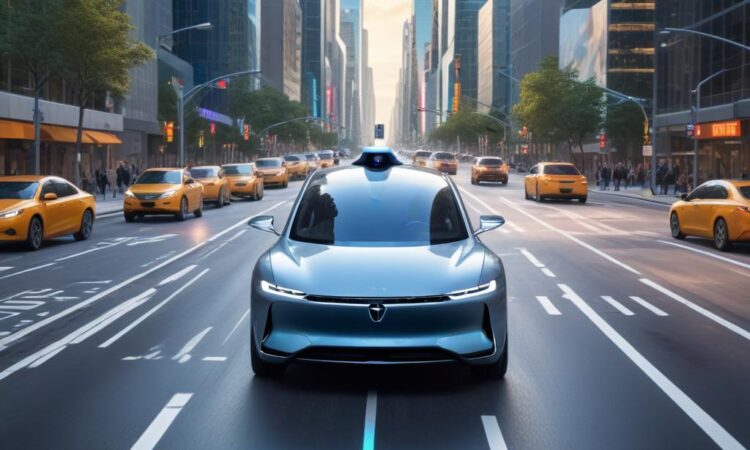Autonomous Vehicles: The Future of Transportation
The development of self-driving cars and other autonomous vehicles continues to gain traction, with increasing trials and regulations. This technological advancement holds immense potential to revolutionize transportation, offering numerous benefits such as increased safety, reduced traffic congestion, and enhanced accessibility for people with disabilities. This comprehensive article explores the evolution of autonomous vehicles, delves into the underlying technology, examines the ethical and legal considerations, and discusses the future implications of this transformative innovation.
A Historical Perspective: The Genesis of Self-Driving Cars
The concept of self-driving cars dates back to the early 20th century, with early prototypes emerging in the 1950s and 1960s. These early attempts were primarily focused on demonstrating the feasibility of autonomous driving, rather than creating practical vehicles for public use. The emergence of advanced technologies like artificial intelligence (AI), computer vision, and sensor fusion has paved the way for significant progress in the field of autonomous vehicles over the past few decades.
One of the key milestones in the development of self-driving cars was the DARPA Grand Challenge, a series of competitions organized by the Defense Advanced Research Projects Agency (DARPA) in the early 2000s. These competitions challenged teams from universities and research institutions to design and develop autonomous vehicles capable of navigating challenging off-road terrains. The success of these competitions spurred significant investment in autonomous vehicle research and development, driving innovation and fostering collaboration among industry players.
The Technology Behind Autonomous Vehicles
Autonomous vehicles rely on a sophisticated suite of technologies to perceive their surroundings, make decisions, and control their movement. Key components include:
- Sensors: These include cameras, radar, lidar, and ultrasonic sensors that gather data about the vehicle’s environment.
- Computer Vision: AI algorithms analyze the sensor data to identify objects, lanes, and other features in the vehicle’s surroundings.
- Mapping and Localization: Precise maps and GPS data help the vehicle determine its location and navigate effectively.
- Path Planning and Control: Advanced algorithms develop optimal driving paths and control the vehicle’s steering, acceleration, and braking.
- Machine Learning: AI algorithms learn from experience, continuously improving the vehicle’s performance and decision-making abilities.
Levels of Autonomy
Autonomous vehicles are classified into different levels of autonomy, ranging from basic driver assistance systems to fully autonomous vehicles capable of driving without human intervention. The Society of Automotive Engineers (SAE) has defined six levels of autonomy:
- Level 0: No Automation: The driver is responsible for all aspects of driving.
- Level 1: Driver Assistance: The vehicle provides limited assistance, such as adaptive cruise control or lane-keeping assist.
- Level 2: Partial Automation: The vehicle can control both steering and acceleration/braking, but the driver must remain attentive and ready to take control.
- Level 3: Conditional Automation: The vehicle can control all aspects of driving in certain conditions, but the driver must be prepared to intervene if needed.
- Level 4: High Automation: The vehicle can drive itself in most conditions, but human intervention may be required in certain scenarios.
- Level 5: Full Automation: The vehicle can drive itself in all conditions, without any human intervention required.
The Benefits of Autonomous Vehicles
The widespread adoption of autonomous vehicles has the potential to bring about significant benefits to society, including:
- Increased Safety: Autonomous vehicles are designed to react faster and more accurately than humans, reducing the incidence of accidents caused by human error.
- Reduced Traffic Congestion: Optimized driving patterns and real-time traffic management systems can help reduce congestion on roads.
- Enhanced Accessibility: Autonomous vehicles can provide transportation options for people with disabilities, seniors, and others who may have difficulty driving.
- Reduced Environmental Impact: Optimized driving patterns and improved traffic flow can lead to reduced fuel consumption and emissions.
- Increased Efficiency: Autonomous vehicles can operate 24/7, potentially leading to increased productivity and efficiency in various industries.
Ethical and Legal Considerations
The development and deployment of autonomous vehicles raise a number of ethical and legal considerations. Some of the key issues include:
- Liability in Accidents: Determining liability in accidents involving autonomous vehicles can be complex, as responsibility may lie with the manufacturer, the owner, or the driver.
- Data Privacy: Autonomous vehicles collect vast amounts of data, raising concerns about data privacy and security.
- Job Displacement: The widespread adoption of autonomous vehicles could lead to job displacement in the transportation sector.
- Accessibility and Equity: Ensuring equitable access to autonomous vehicle technology for all members of society is crucial.
- Ethical Decision-Making: Autonomous vehicles face ethical dilemmas in situations where a collision is unavoidable, requiring careful consideration of ethical decision-making frameworks.
The Future of Autonomous Vehicles
The development of autonomous vehicles is rapidly evolving, with significant progress being made in various areas. The widespread adoption of autonomous vehicles is likely to occur in phases, with initial deployments in controlled environments like highways and private roads. As the technology matures and regulations adapt, autonomous vehicles are expected to become increasingly prevalent in urban environments.
The future of transportation is likely to be shaped by a combination of autonomous vehicles, connected vehicles, and shared mobility services. These advancements have the potential to create a more efficient, sustainable, and equitable transportation system for all. As we move towards a future where autonomous vehicles become an integral part of our lives, it is crucial to address the ethical and legal considerations, ensure responsible development and deployment, and harness the transformative potential of this revolutionary technology for the benefit of society.
Conclusion
Autonomous vehicles represent a significant technological leap forward, with the potential to transform transportation and impact numerous aspects of our lives. While challenges and ethical considerations remain, the benefits of increased safety, reduced congestion, and enhanced accessibility make autonomous vehicles a compelling vision for the future. By embracing responsible innovation and addressing the complexities of this emerging technology, we can unlock the transformative potential of autonomous vehicles and create a more efficient, sustainable, and equitable transportation system for all.

